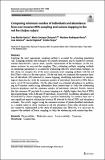Por favor, use este identificador para citar o enlazar a este item:
http://hdl.handle.net/10261/334257COMPARTIR / EXPORTAR:
 SHARE SHARE
 CORE
BASE CORE
BASE
|
|
| Visualizar otros formatos: MARC | Dublin Core | RDF | ORE | MODS | METS | DIDL | DATACITE | |

| Título: | Comparing minimum number of individuals and abundance from non-invasive DNA sampling and camera trapping in the red fox (Vulpes vulpes) |
Autor: | Martin-García, Sara; Cortazar-Chinarro, Maria; Rodríguez-Recio, Mariano; Jiménez, José CSIC ORCID ; Höglund, Jacob; Virgós, Emilio | Fecha de publicación: | 2023 | Editor: | Springer Nature | Citación: | Biodiversity and Conservation 32: 1977-1998 (2023) | Resumen: | Applying the most appropriate sampling method is essential for estimating population size. Sampling methods and techniques to estimate abundance may be limited by environmental characteristics, species traits, specific requirements of the techniques, or the economic resources to carry out the sampling. Thus, evaluating multiple sampling methods in monitoring populations is essential for establishing effective conservation strategies. In this study, we compare two of the most commonly used sampling methods with the red fox (Vulpes vulpes) as the type species. On the one hand, we compared the minimum number of individuals (NI) detected by camera trapping, identifying individuals by morphological characteristics with the minimum number of individuals detected by DNA faeces and a set of 16 microsatellites. On the other hand, we estimated abundance by performing an N-mixture model using information from camera-traps to study the relationship between abundance and the minimum number of individuals detected. Results showed that the minimum NI provided by camera trapping was slightly higher than that of DNA faecal genotyping, with 23.66 and 19 individuals, respectively. In addition, abundance and NI detected by camera trapping showed a positive relationship. In contrast, there was a non-significant negative relationship between NI detected by faecal DNA and abundance estimates. Our results suggest using the minimum number of photo-identified individuals as a reliable index to study variation in red fox abundance when other advanced methods cannot be implemented in the study of population size. However, it is necessary to improve the methods of faecal sampling to study the relationship with camera-trap data. | Versión del editor: | https://doi.org/10.1007/s10531-023-02586-y | URI: | http://hdl.handle.net/10261/334257 | DOI: | 10.1007/s10531-023-02586-y | E-ISSN: | 1572-9710 |
| Aparece en las colecciones: | (IREC) Artículos |
Ficheros en este ítem:
| Fichero | Descripción | Tamaño | Formato | |
|---|---|---|---|---|
| comparivulpes.pdf | 1,82 MB | Adobe PDF |  Visualizar/Abrir |
CORE Recommender
Page view(s)
35
checked on 03-may-2024
Download(s)
24
checked on 03-may-2024
Google ScholarTM
Check
Altmetric
Altmetric
Este item está licenciado bajo una Licencia Creative Commons

